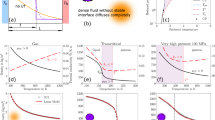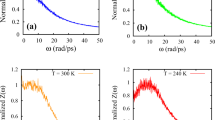Abstract
IN the opinion of Andrews1 the question of the appropriate nomenclature to be applied to a fluid at temperatures and pressures above the critical point “does not admit … of a positive answer. . . . Carbonic acid at 35.5°, and under 108 atmospheres pressure, stands nearly midway between the gas and the liquid ; and we have no valid grounds for assigning it to the one form of matter any more than to the other”. The absence of any sharp visible transition when a substance is taken from the gas state below the critical temperature to the liquid state, also below the critical temperature, by a route which does not enter the two-phase region of the p,v diagram (that is, cross the two-phase line on the T,p diagram), gave rise to the concept of the ‘continuity of gaseous and liquid states’ ; and this has, perhaps, discouraged inquiry into the structural changes which must occur on passing from a dilute gas to liquid. Suggestions concerning the distinction between gaseous and liquid states of hypercritical fluids were made by Thiessen2 in 1897, and later by Eucken3 and by Plank4. In recent years, interest in this subject has revived, and several suggestions have been made5–8 that the hypercritical region of the T,p diagram should be divided into areas corresponding to ‘gas-like’ and ‘liquid-like’ states of matter by what Bernal6 proposes should be called the ‘hypercritical line’. The present communication discusses the criteria which have been suggested for making this subdivision.
This is a preview of subscription content, access via your institution
Access options
Subscribe to this journal
Receive 51 print issues and online access
$199.00 per year
only $3.90 per issue
Buy this article
- Purchase on Springer Link
- Instant access to full article PDF
Prices may be subject to local taxes which are calculated during checkout
Similar content being viewed by others
References
Andrews, T., Phil. Trans. Roy. Soc., 160, 575 (1869).
Thiessen, M., Z. komp. fluss. Gase, 1, 86 (1897).
Eucken, A., Phys. Z., 35, 708 (1934).
Plank, R., Forsch. Geb. Ingen., 7, 161 (1936).
Smith, F. G., Canad. J. Chem., 36, 1131 (1958).
Bernal, J. D., Nature, 184, 141 (1959).
Kaganer, M. G., Zhur. Fiz. Chem. U.S.S.R., 32, 332 (1958).
Jones, G. O., and Walker, P. A., Proc. Phys. Soc., B, 69, 1348 (1956).
Din, F. (ed.), “Thermodynamic Properties of Gases”, 2 (Butterworths, 1957).
Author information
Authors and Affiliations
Rights and permissions
About this article
Cite this article
COUNSELL, J., EVERETT, D. Nature of Fluids in the Hypercritical Region. Nature 188, 576–577 (1960). https://doi.org/10.1038/188576a0
Issue Date:
DOI: https://doi.org/10.1038/188576a0
Comments
By submitting a comment you agree to abide by our Terms and Community Guidelines. If you find something abusive or that does not comply with our terms or guidelines please flag it as inappropriate.



